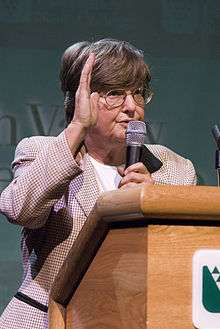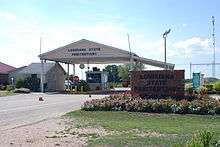Helen Prejean
| Helen Prejean | |
|---|---|
 | |
| Born |
April 21, 1939 Baton Rouge, Louisiana, U.S.A |
| Residence | New Orleans, Louisiana, U.S.A |
| Occupation | Roman Catholic nun, spiritual adviser, author, anti-death penalty activist |
| Religion | Catholic |
Helen Prejean, C.S.J. (born April 21, 1939 in Baton Rouge, Louisiana) is a Roman Catholic nun, a member of the Congregation of St. Joseph and a leading American advocate for the abolition of the death penalty.
Early life and education
Helen Prejean was born in Baton Rouge, Louisiana, the daughter of Augusta Mae (née Bourg; 1911–1993), a nurse, and Louis Sebastian Prejean (1893–1974), a lawyer.[1] She joined the Sisters of Saint Joseph of Medaille in 1957. In 1962, she received a Bachelor of Arts in English and Education from St. Mary’s Dominican College, New Orleans, Louisiana. In 1973, she earned a Master of Arts in religious education from Saint Paul University in Ottawa, Canada. She has been the Religious Education Director at St. Frances Cabrini Parish in New Orleans, the Formation Director for her religious community and has taught junior and senior high school.[2]
Death row ministry
Her efforts began in New Orleans, Louisiana, in 1981. In 1982 an acquaintance asked her to correspond with convicted murderer Elmo Patrick Sonnier, located in the Louisiana State Penitentiary.[3] Sonnier was sentenced to death by electrocution. She visited Sonnier in prison and agreed to be his spiritual adviser in the months leading up to his execution. The experience gave Prejean greater insight into the process involved in executions, and she began speaking out against capital punishment. At the same time, she also founded Survive, an organization devoted to counseling the families of victims of violence.
Prejean has since ministered to many other inmates on death row and witnessed several more executions. She served as National Chairperson of the National Coalition to Abolish the Death Penalty from 1993 to 1995.

Dead Man Walking
Dead Man Walking, a biographical account of her relationship with Sonnier and other inmates on death row, served as the basis for a feature film, an opera, and a play. In the film, she was portrayed by Susan Sarandon, who won an Academy Award for Best Actress. Although Prejean herself was uncredited, she made a minor cameo as a woman in a candlelit vigil scene outside the Louisiana State Penitentiary.[4]
In addition to Sonnier, the account is based on the inmate Robert Lee Willie who, with his friend Joseph Jesse Vaccaro, raped and killed 18-year-old Faith Hathaway on May 28, 1980, eight days later kidnapping a Madisonville couple from alongside the Tchefuncte River in Louisiana and driving them to Alabama. They raped the 16-year-old girl, Debbie Morris (née Cuevas), who would later write the book Forgiving the Dead Man Walking,[5] and then stabbed and shot her boyfriend, 20-year-old Mark Brewster, leaving him tied to a tree paralyzed from the waist down.[6]
In December 2010, Prejean donated all of her archival papers to DePaul University.[7][8]
Campaigns, book, and awards
In 1999, Prejean formed Moratorium 2000, a petition drive that eventually grew into a national education campaign, The Moratorium Campaign,[9] initially staffed by Robert Jones, Theresa Meisz, and Jené O'Keefe. The organization Witness to Innocence,[10] composed of death row survivors who were convicted for crimes they did not commit, started under The Moratorium Campaign.
Prejean's second book, The Death of Innocents: An Eyewitness Account of Wrongful Executions was published in December 2004. In it, she tells the story of two men, Dobie Gillis Williams and Joseph O'Dell, whom she accompanied to their executions. She believes that both men were innocent. The book also examines the recent history of death penalty decisions by the Supreme Court of the United States and looks at the track record of George W. Bush as Governor of Texas.
In 1998, Prejean was given the Pacem in Terris Award, named after a 1963 encyclical letter by Pope John XXIII that calls on all people of good will to secure peace among all nations. Pacem in terris is Latin for "Peace on Earth."
Prejean now bases her work at the Death Penalty Discourse Network in New Orleans and spends her time giving talks across the United States and around the world. She and her sister Mary Ann Antrobus have been deeply involved at a center in Nicaragua called Friends of Batahola.[11]
Awards and recognition
Prejean has given commencement addresses to more than 50 colleges and universities around the world.[12]
- 2013: Robert M. Holstein 'Faith Doing Justice' Award from the Ignatian Solidarity Network
- 1998: World Pacem in Terris Award
- 1996: Pax Christi USA Pope Paul VI Teacher of Peace Award
References
- ↑ "Sister Helen Prejean". University of Louisiana. Retrieved May 27, 2015.
- ↑ "Biography". Ministry Against the Death Penalty. Retrieved June 18, 2013.
- ↑ "CHURCH NEEDS TO AID KILLERS AS WELL AS VICTIMS' FAMILIES, NUN SAYS". Chicago Tribune. January 19, 2006. p. Metro Chicago 8. Retrieved September 1, 2010.
It was at St Thomas in 1982 that an acquaintance asked her to write to Elmo "Pat " Sonnier, a stranger on Death Row.
- ↑ "Trivia for Dead Man Walking". Internet Movie Database. Retrieved December 22, 2015.
- ↑ "Forgiving the Dead Man Walking: Only One Woman Can Tell the Entire Story". Amazon.com. Retrieved December 22, 2015.
- ↑ Buchanan, Christopher. "LOUISIANA: A Murder, a Movie AND a Wink". Frontline. Retrieved December 22, 2015.
- ↑ DeGraff, Kathryn (February 7, 2011). "DePaul Archives Acquire Prejean Death Penalty Papers & Dead Man Walking Manuscript". DePaul University Library. Retrieved May 15, 2015.
- ↑ "DePaul gets papers of 'Dead Man Walking' nun"". Chicago Tribune. February 10, 2011. Retrieved December 22, 2015.
- ↑ "The Moratorium Campaign". Retrieved December 22, 2015.
- ↑ "Witness to Innocence". Witness to Innocence. Retrieved December 22, 2015.
- ↑ VICTORIN-VANGERUD, AARON (June 1, 2011). "Sister Helen Prejean (CSJ) and Mary Ann Antrobus, June 2011". University of Minnesota. Retrieved December 22, 2015.
- ↑ "FINDING AID FOR Sr. Helen Prejean Papers". Series 005.001: University and College Commencements. DePaul University Special Collections and Archives.
External links
- Official website
- Helen Prejean at the Internet Movie Database
- Works by or about Helen Prejean in libraries (WorldCat catalog)
- Appearances on C-SPAN
- The Dead Man Walking School Theatre Project
- Angel on Death Row Newspaper accounts of the crimes and executions of Patrick Sonnier and Robert Lee Willie, Public Broadcasting Service
- "Sister Helen Prejean: The Real Woman Behind Dead Man Walking", by John Bookser Feister, St. Anthony Messenger, April, 1996
- Would Jesus pull the Switch? by Sister Helen Prejean, C.S.J., Salt of the Earth 1997
- Conversation with Sr. Helen Prejean by Marilyn Rodrigues, The Catholic Weekly August 17, 2003
- The National Review and Sr. Helen Prejean, C.S.J., August 1, 2006
- Blood on our Hands: An Interview with Helen Prejean, by Shannon Presler, The Other Journal.com January 19, 2009
- "Walk the Talk Show with Waylon Lewis:Sister Helen Prejean of Dead Man Walking Fame", May 2009
- "The Death Penalty Nun", 2006 video biography